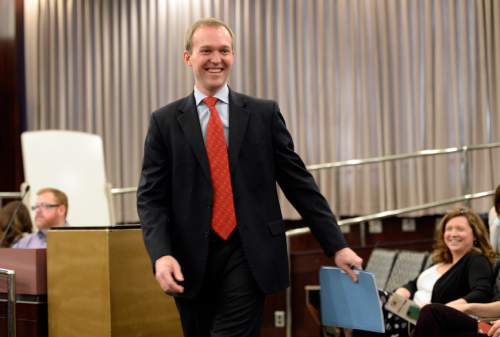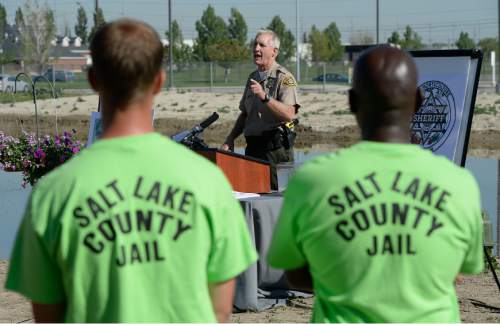This is an archived article that was published on sltrib.com in 2015, and information in the article may be outdated. It is provided only for personal research purposes and may not be reprinted.
Laying out his proposed $1.1 billion budget for 2016, Salt Lake County Mayor Ben McAdams spent more than half of his speech Tuesday focusing on the needs of the county's "broken" criminal-justice system.
He said the county is in a bind because society's approach over the past 20 years of incarcerating too many offenders has produced an unsustainable system.
The Legislature has only made matters worse, McAdams contended, with its unfunded shifting of state prisoners to county jails, plans to build a new prison and its failure to approve Medicaid expansion, which would free up funding for mental-health and substance-abuse treatment that are vital to breaking a cycle of inmates revolving in and out of jail.
"What we've been doing for 20 years isn't working, and it's time to move to alternatives based on data," McAdams said. His preferred alternative is to extend the life of a tax imposed in 1995 to build the Salt Lake County Jail and to use the $9.4 million it generates annually to pay for some changes to the county's approach to criminal justice in the next few years.
How much the County Council shares his vision will be determined over the next month as it goes through the details of the mayor's proposed budget.
Republican council Chairman Richard Snelgrove said there is no doubt that addressing the criminal-justice crisis is "our main issue, not only fiscally, but in terms of lives impacted. We want to get people turned in the right direction — and by success, we mean 'we never see you again.' "
But Snelgrove said he has reservations about continuing the property tax originally intended for jail construction — "it's a tax increase," he said — as well as the mayor's plan to reserve about $18 million over the next three years to repay private investors in three "Pay for Success" programs. Those initiatives are aimed at lowering jail recidivism, minimizing homelessness and improving maternal and child health.
"That's a lot of money to silo, to set aside, for a program that's yet to be proven as viable," said Snelgrove, whose party has a 5-4 council majority. "We'll have to discuss that and see where it takes us."
Besides setting aside about $6 million a year for the next three years, McAdams' criminal-justice funding plan includes:
• An extra $1.9 million for the sheriff's office and $900,000 for the district attorney's office to cover increased caseloads and other operating expenses
• An increase of $820,000 for the Legal Defenders Association to manage its larger caseload and "meet the constitutional right to legal representation, regardless of ability to pay"
• To plan ahead for 2019 when the county would stop putting money into the Pay for Success escrow account and shift the $6 million to the construction of a Community Corrections Center, a secure facility where treatment is emphasized, and to provide more beds and operational funding for the county jail
"My conviction is that we can limit the number of beds by finding the courage today to seize this opportunity to fund immediate public-safety needs now while figuring out how to interrupt the projected flow into the criminal pipeline," McAdams said.
He received polite applause after that line.
The only other reaction from a crowd of county employees who filled the council chambers came in response to McAdams' proposal to eliminate the county's 3 percent annual contribution to the retirement accounts of employees on the county payroll prior to 2011 — about three-fourths of the total.
Several employees booed at that suggested benefit cut. McAdams maintained it was offset by giving employees a 2.5 percent pay increase and continuing the county's annual pension contribution of 18 percent of employees' salaries.
Noting that an ongoing compensation study showed county salaries were marginally low and retirement benefits were high compared to the rest of the market, McAdams said "I made the choice to prioritize pay increases for all employees and to keep their health care costs down while also supporting their opportunity to save for retirement."
The money needed for employee compensation and a projected $3 million expenditure to conduct the 2016 general election ate up all of the $8 million in new revenue the county expects to receive next year.
Some of that funding also will be used to operate three new regional parks that will open in 2016 — Wheadon in Draper, Lodestone on the Kearns/West Valley City border and Southwest in Bluffdale. The county also has put additional money into its Center for the Arts, which will be teaming with Salt Lake City on the planned October 2016 opening of the new George S. and Delores Dore Eccles Performing Arts Center on Main Street in downtown Salt Lake City.
Snelgrove said he is committed to ensuring that the final budget approved by the County Council "does not exceed by one penny what the mayor proposed." He anticipated "additional cuts and efficiencies in areas where we can see some economies of scale."





